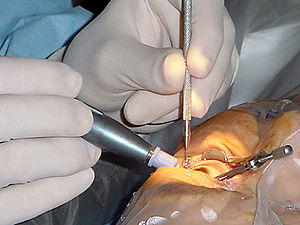The first European patients have been treated for wet age-related macular degeneration with NeoVista's Vidion ANV Therapy System, an epimacular brachytherapy device that delivers a single dose of therapeutic radiation, the manufacturer announced in a press release.
Stanislao Rizzo, MD, of S. Chiara Hospital, Pisa, Italy, treated the initial group of patients with the Vidion ANV Therapy System. Unlike previous radiation therapies for wet AMD, NeoVista's innovative device delivers the peak dose of strontium-90 beta ionizing radiation directly to the lesion minimizing exposure to the surrounding tissue. The minimally invasive procedure utilizes a device similar in size to a needle, to deliver a highly targeted dose of radiation directly to the area of the retina affected by wet AMD. Importantly for patients, the systemic radiation exposure is minimal, as the effective dose to the entire body from NeoVista's epimacular brachytherapy device is less then a routine chest x-ray.
The Vidion system is undergoing phase 3 clinical trials for U.S. Food and Drug Administration marketing approval. The device proved safe and effective in preliminary clinical trials, the release said.
 10:00 AM
10:00 AM
 Keshav Bhat
Keshav Bhat

![Reblog this post [with Zemanta]](http://img.zemanta.com/reblog_e.png?x-id=4aa14112-bbc5-4941-b05e-8460b2e9a131)

![Reblog this post [with Zemanta]](http://img.zemanta.com/reblog_e.png?x-id=0945228d-ea0a-4b03-94a1-2aacd7c05d87)
![Reblog this post [with Zemanta]](http://img.zemanta.com/reblog_e.png?x-id=2425f38c-effb-426d-83fb-00d6f53a6379)

![Reblog this post [with Zemanta]](http://img.zemanta.com/reblog_e.png?x-id=a96d1652-8ab5-4f72-a859-7a30d9bf7102)

![Reblog this post [with Zemanta]](http://img.zemanta.com/reblog_e.png?x-id=21bbca77-14d8-49b5-846d-1b78a64af719)

![Reblog this post [with Zemanta]](http://img.zemanta.com/reblog_e.png?x-id=533358b0-1b21-4d25-bb52-4fc557590aad)

![Reblog this post [with Zemanta]](http://img.zemanta.com/reblog_e.png?x-id=cb673e4f-0865-4943-b553-8492f4d512b7)
![Reblog this post [with Zemanta]](http://img.zemanta.com/reblog_e.png?x-id=830738dc-8a8e-4748-bb9f-30791e47293b)
![Reblog this post [with Zemanta]](http://img.zemanta.com/reblog_e.png?x-id=b577fde8-225b-4a33-b48d-0c81dc92207c)



